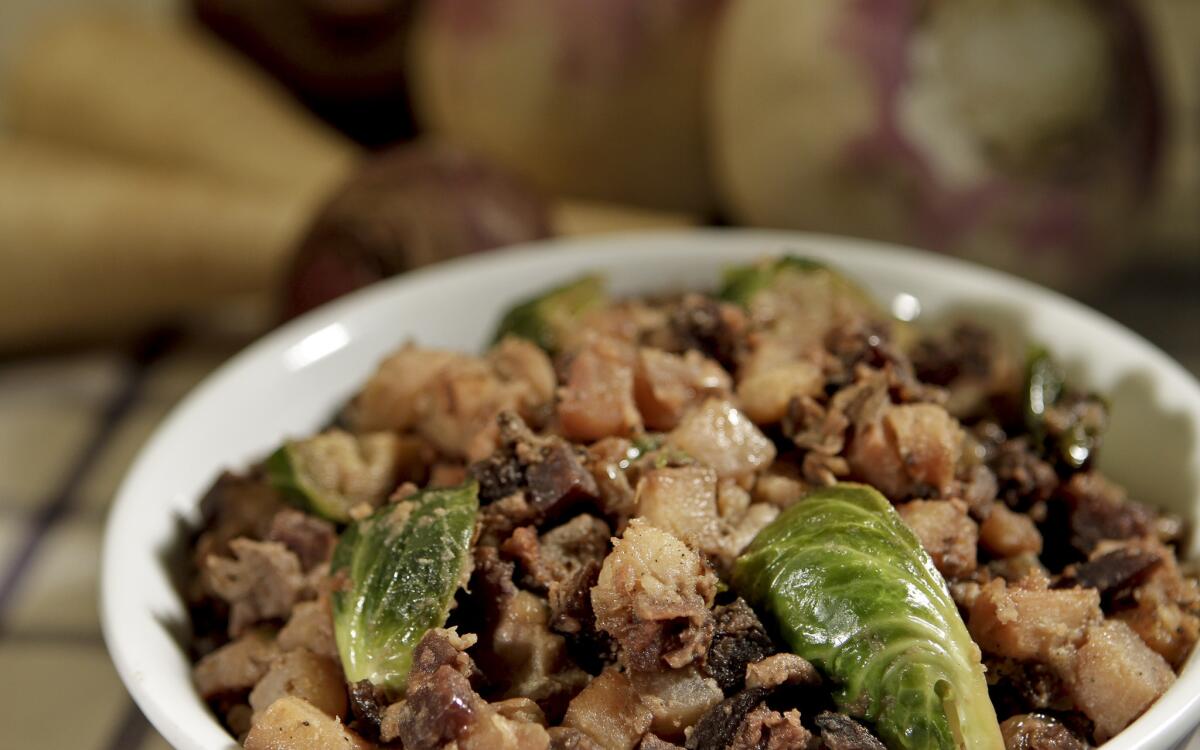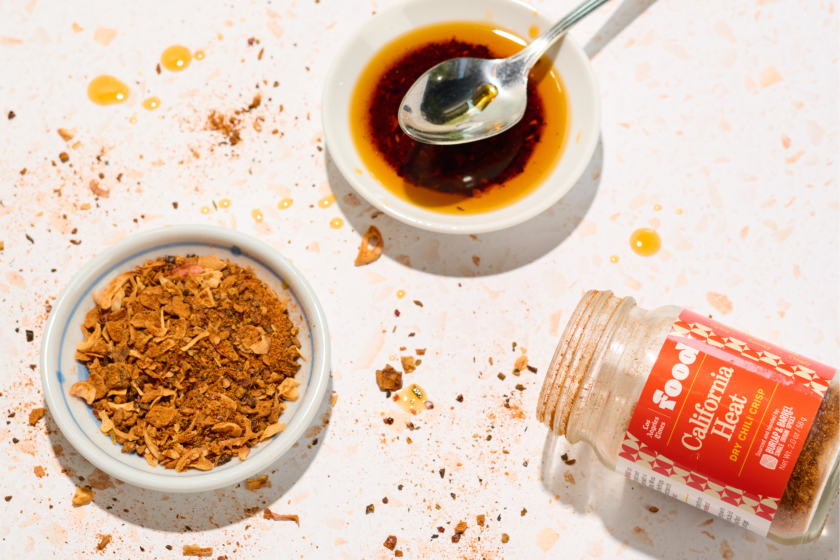Autumn vegetable hash

Generally speaking, the world is composed of two breeds of eaters -- and most everyone knows their tribe. Ask yourself: Does your heart quicken at the sight of a stately crown roast or tenderloin marbled with fat as fine as Carrara? Or do you crave the crisp and fleshy pleasures of the torn drumstick, the gnawed bone, the butt-ends, the drippings, the scraps?
I admit my allegiance: Give me the delicious mess. In other words: Give me hash.
Penny-wise and unabashedly plebeian, hash -- whether roast beef or red flannel, clam or venison, duck or creamed chicken or corned beef -- has deep roots in the domestic life of this country. A leftover-stretcher born from prudence and necessity centuries before the golden arches stole our greasy little hearts, it reigned as the cheap grub of choice for generations of strapped families, roughnecks and working stiffs -- so much so that in its heyday the greasy spoons that served it spawned an entirely original popular lexicon known as “hash house Greek.” (Take your eggs “sunny-side up”? Doff your hat to Michael Casey -- the Bowery boy and hash aficionado who first coined that, and much more of our fry-counter lingo.)
In 1921, Maggie Maloney, a cook for Ohio Sen. Mark Hanna who in her time was celebrated across Washington, D.C., for her unmatchable hash (President McKinley walked to the Hanna home for Sunday breakfast!), was bequeathed $25,000 from her employer’s estate in thanks for her indispensible service. Even today, when its contents are more likely -- and regrettably -- to hail from aluminum cans, a corned beef hash platter remains essential to the menu of any self-respecting American coffee shop or luncheonette.
Like many enduring classics, hash owes its seductiveness to its straightforwardness. In fact, the central formula is so minimal as to render recipes nearly irrelevant: Chop last evening’s leftovers, grab an onion and potato or two, plus a generous plug of whatever fat is at hand, and stir it in a searing hot pan till crispy.
Growing up in New England, I sampled my first hash at the scuffed Formica counter of a railcar diner where my mother and I refueled after mornings of errands -- and it wasn’t long before I’d formed a wicked habit. Scraped from the griddle, dripping with the incandescent smear of a runny yolk, piled willy-nilly and steaming on a plate, and splashed with ketchup, the presentation pleased my childish sense of mischief. The salty shredded beef and the frizzled onions and the crunchy potatoes, on the other hand? They pleased my dopamine pathways. They still do.
U.S. eaters may have done the most to enshrine hash, but iterations of the dish have appeared under myriad names and across culinary cultures. Etymologically, the word owes its origins to the French term hacher, which means “to chop” -- indeed, “Larousse Gastronomique” catalogs scores of hash recipes, though most differ from the late-American style by being composed primarily of minced meat without the addition of onions, potatoes or other extenders like beets or carrots. (The exception to this is hachis Parmentier, a Gallic riff on shepherd’s pie -- itself a kind of hash -- which pairs a chopped beef stew with mashed potatoes.)
Whatever it’s called, hash has also been proved to be a superior hangover aid: a rich morning-after ballast built out of starch and grease that’s restorative and fortifying. Perhaps it is its nursery simplicity, but hash soothes and speaks of the luxuries of home.
Happily, a platter of hash fine enough to rival any restaurant version is entirely within reach of the amateur cook. If you’ve got a wide skillet and a sense of thrift, you’ve got a start. And as the wise food essayist John Thorne writes, “Hash is one of those dishes that to taste is to know how to make.”
In the hopes of re-creating the blue-plate special of my childhood, I’ve spent many a recent morning in the kitchen, chopping roasts and crying over onions. In doing so, I’ve learned not only to marvel at the accommodating nature of the dish but also to respect the care that the truly worthy versions require.
Mix and match
The gist is this: Simple, hash should be, sloppy, it should not. You can let your leftovers be your prompt -- are you looking at half a roast chicken? A slab of roast beef? A lonesome filet of salmon? Those are good starts, but don’t think you can throw rubbish into a pan and expect that simply christening it hash will make it delicious. Jettison anything that’s been lingering in the refrigerator more than a day or two.
In this way, planning ahead helps. Now that I’ve gotten in the habit of preparing my own hash, I purposely pad the quantities in my suppers so that there’ll be scraps for the pan later. Those scraps should still have color -- after all, they have to stand up to being cooked twice. But Friday’s slow-roasted pork loin can be reborn as a beautiful autumn breakfast when combined with bacon, apples and a bit of curry on Saturday morning.
Fat lays the groundwork for all hashes, and is therefore another essential part of the equation. You can’t go wrong by beginning with thick, creamy butter -- especially if you use plenty of it. And olive oil is convenient and pleasantly neutral. But for an even fuller foundation of flavor, a dab of bacon fat -- or, if you feel like gilding the lily, duck fat or goose fat -- goes a long way. Start with a bit of pancetta or crumbled chorizo sausage and elevate a chicken and chile hash into a layered and hearty cool-weather lunch. Add goose fat to a pan of diced root vegetables right from the market, let your flame work its magic, and be prepared to be bowled over.
It’s all in the prep
With hash, the action all occurs in a single skillet, preferably cast iron, or if you’re lucky enough to have one, a real flat-top griddle. That means that the bulk of a cook’s labor comes in prep: the shredding, the dicing, the chopping. There are certainly shortcuts that can be taken with a food processor, though I’ve found that with the exception of “diner-style” beef hash -- in which potatoes, onions and beef really should be minced together to a fine shred -- the best hashes are those cut by hand, in petite, uniform cubes. (Think of it as practicing scales for your knife skills.)
And on the occasions when you want to keep potentially overpowering flavors distinct -- for those starring smoked fish or clams, for instance -- try cooking the supporting ingredients in batches and then stirring in the lead only toward the end.
Hash can be served plain and slightly crumbly or bound first with a bit of stock, lemon juice or tomato puree. Some of the loveliest versions -- like the legendary chicken hash from the 21 Club in New York -- get their velvety sheen from a generous glug of cream.
The godfather of American cooking, James Beard, knew a thing or two about hash, and in the course of his career championed dozens of versions in cookbooks. One of his particular favorites, not much seen these days, calls for the hash to be baked until a firm crust forms across the top. Try it -- and be prepared for a dinner table scuffle to claim the crunchy bits.
But in the end, baked or sauteed, beet or beef, it’s all just hash: a supper for queens and stevedores, thugs and starlets -- and you and me.
In a large skillet over medium heat, melt the goose fat. Add the onions and garlic to the skillet and cook, stirring occasionally, until the onions are softened and have begun to turn golden, about 5 minutes.
Stir in the sweet potatoes, spreading them out so they’re spaced in an even layer in the pan. (The more of their surface area that is in contact with the pan, the more the potatoes will brown and crisp.) Cover the skillet and cook the potatoes for a few minutes, without stirring, then give them a quick toss around the skillet, scraping up any crusty bits that have formed. Stir in the parsnips and turnips, then re-cover the skillet and continue to cook until all the potatoes are browned and crunchy at the edges and the parsnips and turnips are fork tender and slightly golden, about 10 minutes.
Add the Brussels sprouts and mushrooms to the skillet, along with the sage and mustard powder. Season to taste with salt and pepper and give the hash a quick stir. Cook, covered, an additional 5 minutes, then turn the hash in portions, scraping the crispy bits from the bottom of the pan and mixing them into the hash.
Stir the beets into the hash, cover, and cook an additional few minutes to marry the flavors. Drizzle in cream, stirring and scraping up the rest of the browned bits from the bottom of the pan as you go. Season once more with salt and pepper to taste, and serve.
Get our Cooking newsletter.
Your roundup of inspiring recipes and kitchen tricks.
You may occasionally receive promotional content from the Los Angeles Times.















